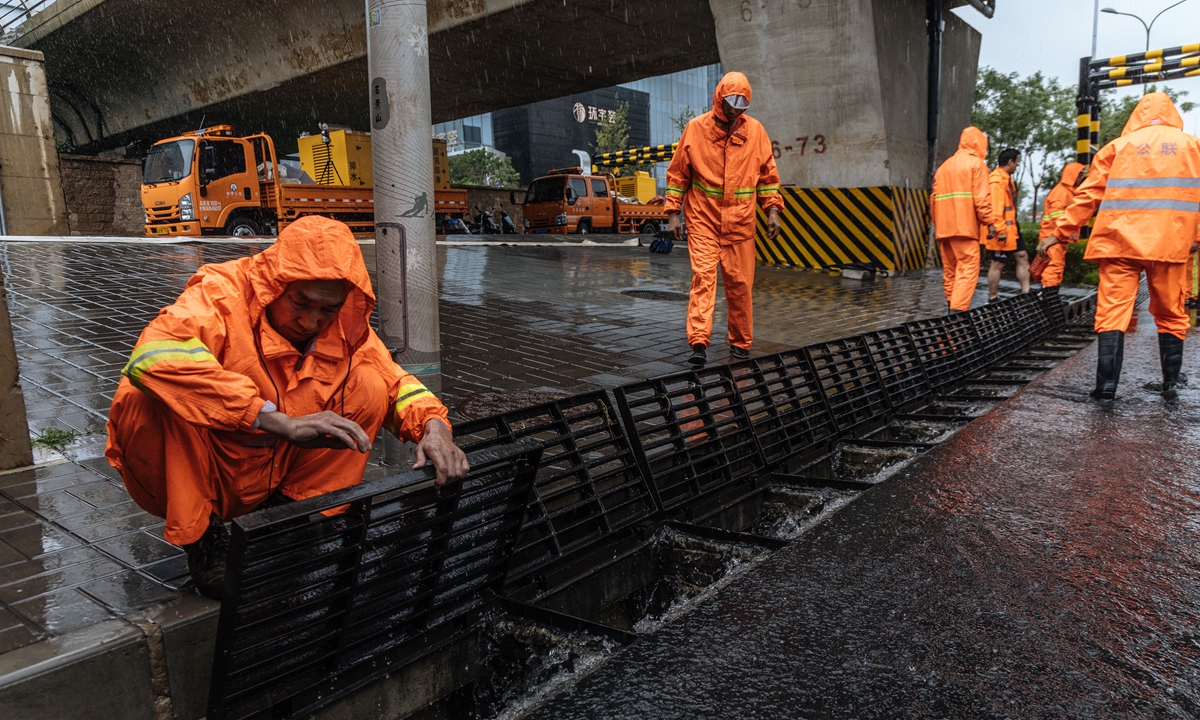
Emergency response personnel stand ready at an underpass prone to waterlogging in Shijiangshan district in southwestern Beijing to prepare for emergencies on July 30, 2023 as the metropolis has posted a highest-level red alert for heavy rainstorms brought by the remnants of Typhoon Doksuri. Beijing authorities have been in full preparations for the heavy rainstorms that have swept across the city. Photo: Li Hao/GT
The extreme rainstorm witnessed in Beijing on July 21, 2012, the heaviest rainfall in six decades that
left 79 people dead and caused widespread havoc in the capital city over a weekend, left deep scars in many people's hearts. Fortunately, when Beijing broke a 140-year-old rainfall record in the days between July 29 and August 2, the nightmare witnessed by Beijing residents over a decade ago were not replayed.
Based on flood prevention experience and lessons learned from previous rainfall disasters, including the catastrophic Henan floods in July 2021, Beijing appears to have made quantifiable to the city's disaster forecasting, relief, and response programs. There have been no major recorded roof collapses, backlash on the internet, damage of power lines, or flooded highway underpasses, scenes that were widely seen in the tragedy 11 years ago.
New technology and digital networks have become an important force in averting tragedy. The Beijing Haidian District Water Affairs Bureau utilized a cutting-edge smart system to direct emergency rescue operations throughout the district, as the system can map out the most optimal rescue route in record time.
The system utilizes visualization, integrated analysis of big data, and other technologies to understand the distribution and anomalies of approximately 3,000 water facilities and sensors across the entire Haidian area, and can provide real-time monitoring of the status of water channels, gates, and dams, and respond to warnings and forecasts speedily, the Beijing News reported.
Moreover, technologies such as the "Sky Eye" telescope, radar maps, and satellite cloud images have also played a significant role in this round of rainstorm warning. Since the start of the current round of rainfall on July 29, the "Sky Eye" smart system installed in some streets has remained vigilant. High-definition cameras installed on flood prevention emergency vehicles and rescue team helmets can monitor precipitation in real time, greatly improving the efficiency of flood responses.
"Early assessment, early warning, and early deployment" are the most significant forms of progress that the Global Times witnessed amid the slate of heavy rain that hit Beijing.
While visiting and reporting in waterlogged Zhengzhou, the capital of Henan Province, in July 2021, Global Times reporters found that the consensus among the public was they received warning notifications "too late." While other areas in Henan Province had already been hit by heavy downpours, Zhengzhou city government did not decisively put measures in place to stop gatherings, suspend classes, and require the closure of businesses, wasting critical time in flood prevention and missing a key rescue window.
The official investigation report on the severe rainstorm disaster in Zhengzhou which caused at least 398 deaths and missing, exposed serious misconducts in the city's response deployment, including inadequate warning, significant delays in emergency responses, and a lack of unified command at critical moments. These issues led to the highest disaster-related casualties seen in recent years, particularly with regard to the subway system and tunnel, which should not have occurred.
This time in Beijing, Global Times reporters found residents in the capital city received multiple flood prevention reminders via text from relevant departments before the heavy rain actually fell down. Beijing successively issued red rainstorm warnings, yellow lightning warnings, and blue wind warnings, reminding citizens to refrain from outdoor activities. Many organizations immediately issued directives for their employees to work from home.
News sources reported that in preparation, the Beijing Drainage Group initiated a top-level flood early-warning protocol, requiring all pump station personnel to be on duty. At the same time, a re-inspection and re-treatment of drainage facilities in key areas such as 155 depressed bridges and 249 subway stations, as well as a re-inspection of water pumps, backup power sources, flood control emergency equipment, and various monitoring systems in 87 rainwater pump stations across the city were conducted.
Power system companies also deployed emergency teams in advance. The State Grid Corporation of China (Beijing), for example, had 22 rescue teams with 510 personnel on standby, ready to transport power generation vehicles, small generators, lighting vehicles, and other flood control emergency supplies and equipment to be stationed in areas with strong rainfall forecasted by meteorological bodies.
Beijing's main cultural and tourism venues issued temporary closure notices soon after the Beijing city government temporarily asked to shut down access to all scenic spots on July 30.
All mountainous and water-related scenic spots and rural homestays in the heavily affected area of Fangshan district were temporarily closed and have stopped receiving visitors since then. All 17 tourist attractions in Huairou district were closed, and all homestays and folk accommodations were temporarily suspended to minimize risk.
Amid the heavy downpour sweeping through many parts of China, local authorities have stepped up efforts to counter flooding and power cuts. After days of search and evacuation efforts, disinfection work has begun in residential and commercial areas in the city over this weekend.
Throughout three major rainstorms, nonstop rescue missions have been executed with countless heartwarming stories. In the last decade, what has changed is our continuously honed ability to respond to floods, while what remains unchanged is the resilience exemplified by every individual, an essence of the Chinese civilization.
We believe that in the future, we will face floods and other natural disasters with even greater composure and unite together to withstand the tests they bring.




